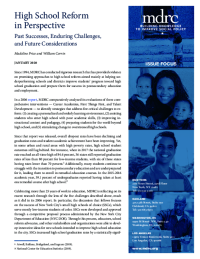High School Reform in Perspective
Past Successes, Enduring Challenges, and Future Considerations

Since 1994, MDRC has conducted rigorous research that has provided evidence on promising approaches to high school reform aimed mainly at helping underperforming schools and districts improve students’ progress toward high school graduation and prepare them for success in postsecondary education and employment.
In a 2006 report, MDRC comparatively analyzed its evaluations of three comprehensive interventions — Career Academies, First Things First, and Talent Development — to identify strategies that address five critical challenges to reform: (1) creating a personalized and orderly learning environment, (2) assisting students who enter high school with poor academic skills, (3) improving instructional content and pedagogy, (4) preparing students for the world beyond high school, and (5) stimulating change in overstressed high schools.
Since that report was released, overall dropout rates have been declining and graduation rates and student academic achievement have been improving. Yet, in some urban and rural areas with high poverty rates, high school student outcomes still lag behind. For instance, when in 2017 the national graduation rate reached an all-time high of 84.6 percent, 36 states still reported graduation rates of less than 80 percent for low-income students, with six of those states having rates lower than 70 percent.[1] Additionally, many students continue to struggle with the transition to postsecondary education and are underprepared for it, leading them to enroll in remedial education courses. In the 2015-2016 academic year, 39.1 percent of undergraduates reported having taken at least one remedial course after high school.[2]
Celebrating more than 25 years of work in education, MDRC is reflecting on its recent research through the lens of the five challenges described above, much as it did in its 2006 report. In particular, this Issue Focus looks at the success of New York City’s small high schools of choice (SSCs), which serve mostly low-income students of color. SSCs were developed and approved through a competitive proposal process administered by the New York City Department of Education. Through this process, educators, school reform advocates, and other stakeholders and organizations were able to develop innovative ideas for new schools intended to improve high school education in the city.






